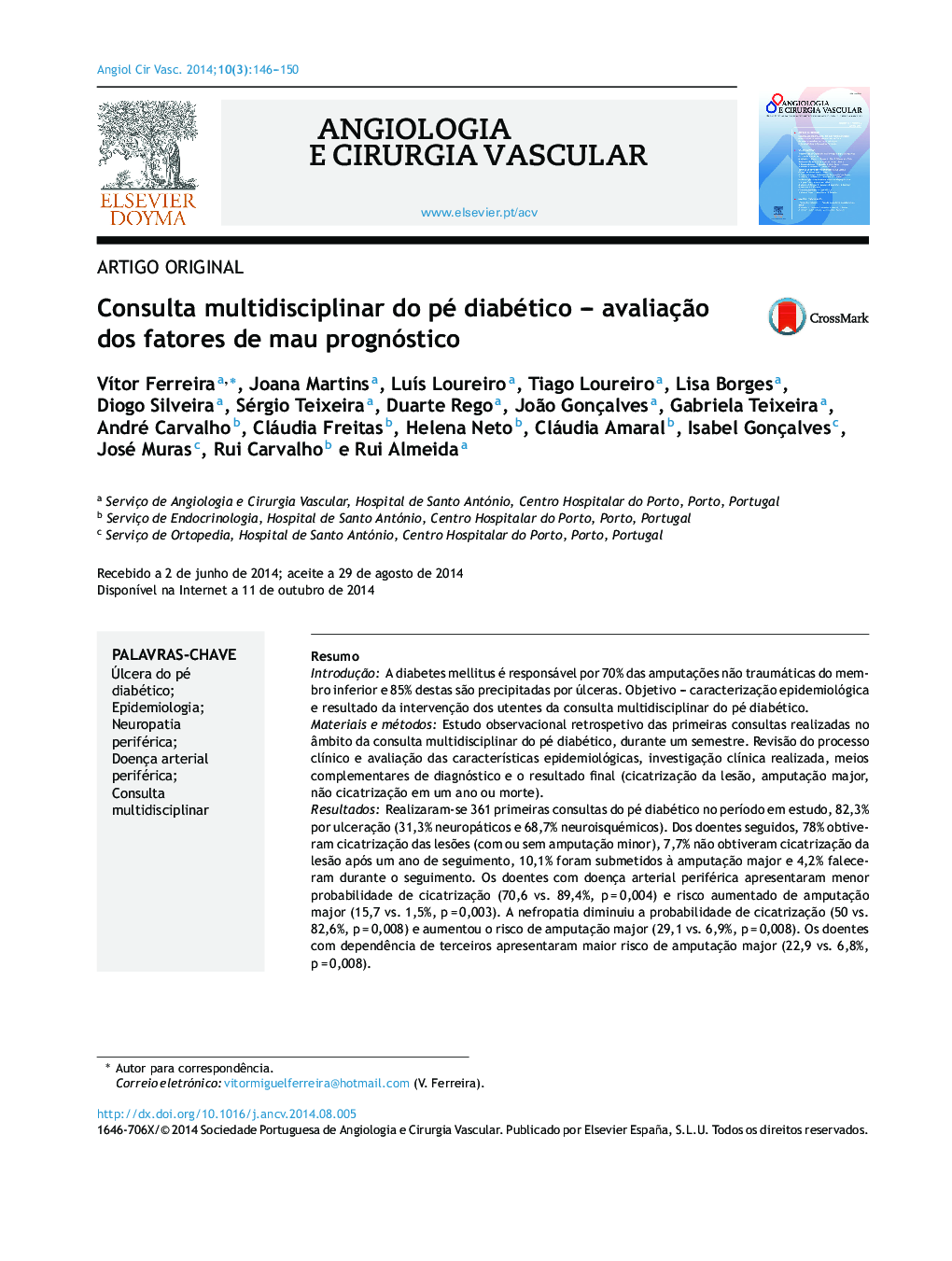| Article ID | Journal | Published Year | Pages | File Type |
|---|---|---|---|---|
| 2868374 | Angiologia e Cirurgia Vascular | 2014 | 5 Pages |
ResumoIntroduçãoA diabetes mellitus é responsável por 70% das amputações não traumáticas do membro inferior e 85% destas são precipitadas por úlceras. Objetivo – caracterização epidemiológica e resultado da intervenção dos utentes da consulta multidisciplinar do pé diabético.Materiais e métodosEstudo observacional retrospetivo das primeiras consultas realizadas no âmbito da consulta multidisciplinar do pé diabético, durante um semestre. Revisão do processo clínico e avaliação das características epidemiológicas, investigação clínica realizada, meios complementares de diagnóstico e o resultado final (cicatrização da lesão, amputação major, não cicatrização em um ano ou morte).ResultadosRealizaram‐se 361 primeiras consultas do pé diabético no período em estudo, 82,3% por ulceração (31,3% neuropáticos e 68,7% neuroisquémicos). Dos doentes seguidos, 78% obtiveram cicatrização das lesões (com ou sem amputação minor), 7,7% não obtiveram cicatrização da lesão após um ano de seguimento, 10,1% foram submetidos à amputação major e 4,2% faleceram durante o seguimento. Os doentes com doença arterial periférica apresentaram menor probabilidade de cicatrização (70,6 vs. 89,4%, p = 0,004) e risco aumentado de amputação major (15,7 vs. 1,5%, p = 0,003). A nefropatia diminuiu a probabilidade de cicatrização (50 vs. 82,6%, p = 0,008) e aumentou o risco de amputação major (29,1 vs. 6,9%, p = 0,008). Os doentes com dependência de terceiros apresentaram maior risco de amputação major (22,9 vs. 6,8%, p = 0,008).ConclusõesO tratamento eficaz das úlceras do pé diabético necessita uma abordagem multidisciplinar, intervindo nos vários componentes etiológicos. A doença arterial periférica, a insuficiência renal e a dependência de terceiros são fatores de mau prognóstico das úlceras do pé diabético.
IntroductionDiabetes mellitus is responsible for 70% of non‐traumatic lower limb amputations and 85% of these are precipitated by ulcers. Objective ‐ epidemiological characterization and revision of the outcome of patients observed in a multidisciplinary outpatient clinic of diabetic foot.Matherials and methodsA retrospective observational study with review of the first consultation of the multidisciplinary outpatient clinic of diabetic foot ulcer, during one semester. Review of the clinical process and evaluation of the epidemiological characteristics, clinical investigation, diagnostic tests, and outcome (healing, major amputation, non‐healing after 1 year or death).ResultsThere were 361 first consultations during the study period, 82.3% due to ulceration (31.3% with neuropathic etiology and 68.7% with neuroischemic foot ulcers). Of the patients followed, 78% achieved complete wound healing (with or without minor amputation), 7.7% did not heal after one year of follow up, 10.1% underwent major limb amputation, and 4.2% died during the follow‐up. Patients with peripheral arterial disease were less likely to heal (70.6% vs. 89.4%, p = 0.004) and had greater risk of major amputation (15.7% vs. 1.5%, p = 0.003). Nephropathy decreases the likelihood of healing (50% vs. 82.6%, p = 0.008) and increases the risk of major amputation (29.1% vs. 6.9%, p = 0.008). Non‐ambulatory patients have a higher risk of major amputation (22.9% vs. 6.8%, p = 0.008).ConclusionsSuccessful treatment of diabetic foot ulcers requires a multidisciplinary approach, intervening in all etiological components. Peripheral arterial disease, renal failure and non ambulatory status are factors related to poor prognosis of diabetic foot ulcers.
